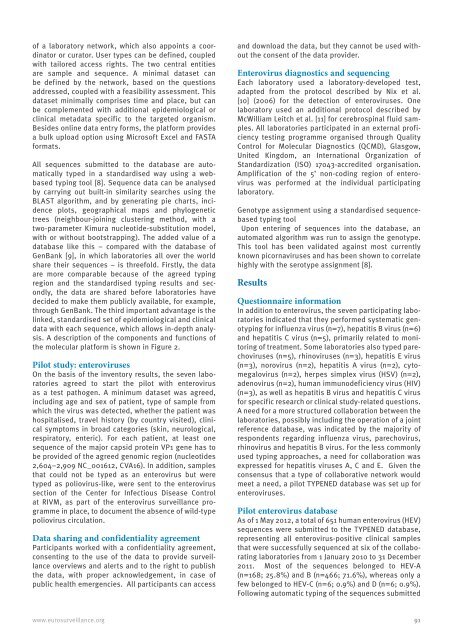Neisseria meningitidis - Eurosurveillance
Neisseria meningitidis - Eurosurveillance
Neisseria meningitidis - Eurosurveillance
You also want an ePaper? Increase the reach of your titles
YUMPU automatically turns print PDFs into web optimized ePapers that Google loves.
of a laboratory network, which also appoints a coordinator<br />
or curator. User types can be defined, coupled<br />
with tailored access rights. The two central entities<br />
are sample and sequence. A minimal dataset can<br />
be defined by the network, based on the questions<br />
addressed, coupled with a feasibility assessment. This<br />
dataset minimally comprises time and place, but can<br />
be complemented with additional epidemiological or<br />
clinical metadata specific to the targeted organism.<br />
Besides online data entry forms, the platform provides<br />
a bulk upload option using Microsoft Excel and FASTA<br />
formats.<br />
All sequences submitted to the database are automatically<br />
typed in a standardised way using a webbased<br />
typing tool [8]. Sequence data can be analysed<br />
by carrying out built-in similarity searches using the<br />
BLAST algorithm, and by generating pie charts, incidence<br />
plots, geographical maps and phylogenetic<br />
trees (neighbour-joining clustering method, with a<br />
two-parameter Kimura nucleotide-substitution model,<br />
with or without bootstrapping). The added value of a<br />
database like this – compared with the database of<br />
GenBank [9], in which laboratories all over the world<br />
share their sequences – is threefold. Firstly, the data<br />
are more comparable because of the agreed typing<br />
region and the standardised typing results and secondly,<br />
the data are shared before laboratories have<br />
decided to make them publicly available, for example,<br />
through GenBank. The third important advantage is the<br />
linked, standardised set of epidemiological and clinical<br />
data with each sequence, which allows in-depth analysis.<br />
A description of the components and functions of<br />
the molecular platform is shown in Figure 2.<br />
Pilot study: enteroviruses<br />
On the basis of the inventory results, the seven laboratories<br />
agreed to start the pilot with enterovirus<br />
as a test pathogen. A minimum dataset was agreed,<br />
including age and sex of patient, type of sample from<br />
which the virus was detected, whether the patient was<br />
hospitalised, travel history (by country visited), clinical<br />
symptoms in broad categories (skin, neurological,<br />
respiratory, enteric). For each patient, at least one<br />
sequence of the major capsid protein VP1 gene has to<br />
be provided of the agreed genomic region (nucleotides<br />
2,604–2,909 NC_001612, CVA16). In addition, samples<br />
that could not be typed as an enterovirus but were<br />
typed as poliovirus-like, were sent to the enterovirus<br />
section of the Center for Infectious Disease Control<br />
at RIVM, as part of the enterovirus surveillance programme<br />
in place, to document the absence of wild-type<br />
poliovirus circulation.<br />
Data sharing and confidentiality agreement<br />
Participants worked with a confidentiality agreement,<br />
consenting to the use of the data to provide surveillance<br />
overviews and alerts and to the right to publish<br />
the data, with proper acknowledgement, in case of<br />
public health emergencies. All participants can access<br />
www.eurosurveillance.org<br />
and download the data, but they cannot be used without<br />
the consent of the data provider.<br />
Enterovirus diagnostics and sequencing<br />
Each laboratory used a laboratory-developed test,<br />
adapted from the protocol described by Nix et al.<br />
[10] (2006) for the detection of enteroviruses. One<br />
laboratory used an additional protocol described by<br />
McWilliam Leitch et al. [11] for cerebrospinal fluid samples.<br />
All laboratories participated in an external proficiency<br />
testing programme organised through Quality<br />
Control for Molecular Diagnostics (QCMD), Glasgow,<br />
United Kingdom, an International Organization of<br />
Standardization (ISO) 17043-accredited organisation.<br />
Amplification of the 5’ non-coding region of enterovirus<br />
was performed at the individual participating<br />
laboratory.<br />
Genotype assignment using a standardised sequencebased<br />
typing tool<br />
Upon entering of sequences into the database, an<br />
automated algorithm was run to assign the genotype.<br />
This tool has been validated against most currently<br />
known picornaviruses and has been shown to correlate<br />
highly with the serotype assignment [8].<br />
Results<br />
Questionnaire information<br />
In addition to enterovirus, the seven participating laboratories<br />
indicated that they performed systematic genotyping<br />
for influenza virus (n=7), hepatitis B virus (n=6)<br />
and hepatitis C virus (n=5), primarily related to monitoring<br />
of treatment. Some laboratories also typed parechoviruses<br />
(n=5), rhinoviruses (n=3), hepatitis E virus<br />
(n=3), norovirus (n=2), hepatitis A virus (n=2), cytomegalovirus<br />
(n=2), herpes simplex virus (HSV) (n=2),<br />
adenovirus (n=2), human immunodeficiency virus (HIV)<br />
(n=3), as well as hepatitis B virus and hepatitis C virus<br />
for specific research or clinical study-related questions.<br />
A need for a more structured collaboration between the<br />
laboratories, possibly including the operation of a joint<br />
reference database, was indicated by the majority of<br />
respondents regarding influenza virus, parechovirus,<br />
rhinovirus and hepatitis B virus. For the less commonly<br />
used typing approaches, a need for collaboration was<br />
expressed for hepatitis viruses A, C and E. Given the<br />
consensus that a type of collaborative network would<br />
meet a need, a pilot TYPENED database was set up for<br />
enteroviruses.<br />
Pilot enterovirus database<br />
As of 1 May 2012, a total of 651 human enterovirus (HEV)<br />
sequences were submitted to the TYPENED database,<br />
representing all enterovirus-positive clinical samples<br />
that were successfully sequenced at six of the collaborating<br />
laboratories from 1 January 2010 to 31 December<br />
2011. Most of the sequences belonged to HEV-A<br />
(n=168; 25.8%) and B (n=466; 71.6%), whereas only a<br />
few belonged to HEV-C (n=6; 0.9%) and D (n=6; 0.9%).<br />
Following automatic typing of the sequences submitted<br />
91
















